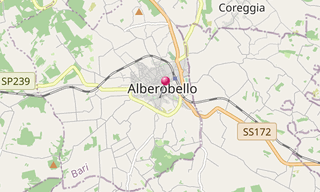Alberobello (literally “beautiful tree”) is a small town in the province of Bari, in Puglia. It is famous for its unique trulli constructions. The Trulli of Alberobello are part of the UNESCO World Heritage Site list since 1996. A first anthropization of the area started only in the early 16th century on the impulse of the Count of Conversano Andrea Matteo III Acquaviva d’Aragona, son of the famous Count Giulio Antonio Acquaviva, who died in 1481 near Otranto, when 800 martyrs were killed in battle against the Ottomans. Count Andrea Matteo introduced from the fief of Noci about forty peasant families to reclaim and cultivate the land, with the obligation to give him the tenth of the crops.
The history of these very particular buildings is linked to the Prammatica de Baronibus, an edict of the 15th century Kingdom of Naples that subjected every new urban settlement to a tribute. The Counts of Conversano d’Acquaviva d’Aragona from 1481, owners of the territory on which Alberobello stands today on the border with the territory of the duchy of Martina Franca, then imposed on the peasants sent in these lands they built their dwellings dry, without using mortar, so that they could be configured as precarious buildings, easily demolished.
Therefore, having to use only stones, the peasants found in the round form with self-supporting domed roof, composed of overlapping stone circles, the simplest and most solid configuration. The domed roofs or half cone for straw, called the false dome of the trulli, are embellished with decorative pinnacles that represented the signature of the master trullaro who did it. The whose form is inspired by profane symbolic, mystical and religious elements.

.hero.landscape.jpg?w=1600)


.jpg?w=256)
.jpg?w=256)
.jpg?w=256)
.jpg?w=256)
.jpg?w=256)
.jpg?w=256)
.jpg?w=256)
.jpg?w=256)
.jpg?w=256)
.jpg?w=256)
.jpg?w=256)
.jpg?w=256)
.jpg?w=256)
.jpg?w=256)
.jpg?w=256)
.jpg?w=256)
.jpg?w=256)
.jpg?w=256)
.jpg?w=256)
.jpg?w=256)
.jpg?w=256)
.jpg?w=256)
.jpg?w=256)
.jpg?w=256)
.jpg?w=256)
.jpg?w=256)
.jpg?w=256)
.jpg?w=256)
.hero.jpg?w=320)

.hero.jpg?w=320)
.map.png)